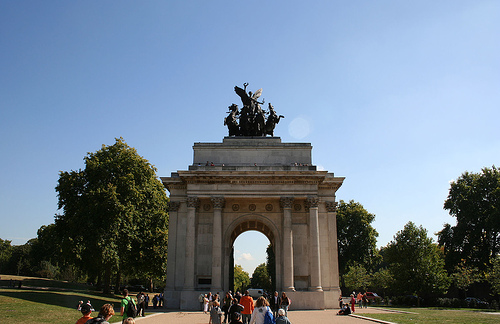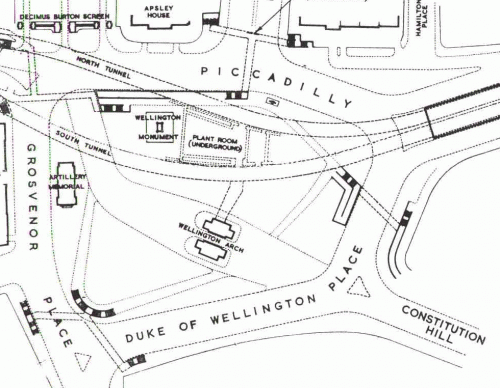Running under Hyde Park Corner is a road tunnel built in the 1960s to relieve congestion on the roundabout above, and sitting slap bang in the middle of Hyde Park Corner, surrounded by war memorials is a gigantic ventilation shaft to extract car pollution from below.
What? You’ve never seen it?
I bet you have!
Here it is…
Yes, that’s the Wellington Arch, and fully a third of it is given over to a huge ventilation shaft running from the roof down to the road tunnel below.
Actually, you might read in some places that the shaft goes down to the London Underground, but those claims are wrong — it’s the road tunnel that it was designed for. As far as I can find out, it is not in use anymore, which is as much down to the reduction in pollution from road vehicles as to the fact that the bottom is reputedly flooded.
But, how on earth did a third of this monumental arch end up being requisitioned for the extraction of foul air?
 www.admlc.org.uk/documents/UCL_Pres6a.pdf
www.admlc.org.uk/documents/UCL_Pres6a.pdf
We have to go back a bit.
A scheme to revamp Hyde Park Corner had been drawn up as early as 1947, but it was not until 1958 that a bill was passed in Parliament authorising the construction of what we have today.
Two 1,000 foot long tunnels were sliced into the ground between Knightsbridge and Piccadilly and running under what would become the modern day roundabout island.
Although surrounded by roads, it was always part of the concept that the roundabout would act as a green island between Hyde Park and Green Park, so it was decorated accordingly, and has since become a key location for war memorials.
Oh, and the Wellington Arch, which was moved from its location opposite Apsley House to its new position facing down Constitution Hill towards Buckingham Palace in 1882-3 became the centre of the new roundabout.
The construction of the cut/cover road tunnels uses a technique common today, but revolutionary at the time. They dug a slice out of the ground, then filled it with a liquid clay called Bentonite, and then displaced that with concrete.
Doing that along the length of the road, you end up with two walls of concrete lining the road tunnel, and then they excavated out the soil in between, and fitted a floor and roof. One road tunnel.
A side shaft was constructed leading from the arch to the tunnel. In the north side of the arch, there had been a small police station, and resident cat — but both were evicted to make way for the removal of burnt petrol vapours instead.
On 17th October 1962, the former Duke of Wellington, Gerald Wellesley formally declared the underpass open, and the arch named after his illustrious forebear, started sucking air out of the tunnel.
The approaching road slopes to the tunnels incidentally can be heated in winter — or at least they could at the time. No idea if that still works.
—
It’s worth noting that the road tunnel at Hyde Park Corner was only part of a much larger scheme that also saw the roundabout, car park and subways constructed at its counterpart at Marble Arch. Combined, the project was one of the largest post-war road changes proposed.
The construction works also needed a temporary bridge over another road — as can be seen in this Pathe News clip starting at around the 1:50 mark.
Before anyone asks, despite much effort and a several requests, no I don’t have any photos of the ventilation shaft itself.









Who’d have thought that was buried in there… That said I’ve been inside the arch and did wonder why it seemed asymmetrical.
I’ve heard somewhere (can’t remember where!) that a concession was made, during the legislative process that underpinned the upgrading of Park Lane to a dual carriageway, to ensure that all the sections of Hyde Park would remain accessible to the public despite the western carriageway road slicing through some of it. This gave rise to the rather unique and now-fenced-off ‘central island only exits’ on all the pedestrian subways that cross Park Lane, as well as the particularly mysterious (and sadly also boarded up) dead-end subway that leads from the back of Apsley House to the traffic island with the statue of Byron (street view ).
Apologies, made a mess of the link above – here’s another attempt at the street view of the long-lost subway.
That’s really interesting!
I tried to see the entrance to the shaft inside the tunnel but Google’s cameras must have been set for daylight only, it’s too dark in there!
This seems like a potential location for the shaft: http://goo.gl/maps/1nvmb
Anyone in the area (want to risk a fine?) who’s brave enough to take a photo in the tunnel? Well, better not I suppose…
This is a bit more promising.
http://goo.gl/5nx6RO
I seem to remember a robbery in the tunnel when I was younger. A armoured van drove in, road closure signs were erected, the van did not drive out.
That’s the beginning sequences of the TV drama Windows where a notorious London Bolan is believed to be killed with his acomplses and the wifes (widows) take over the robbers work.